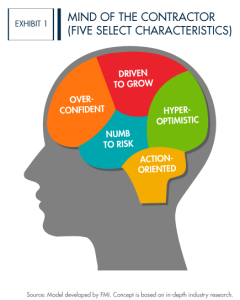The Icarus Leader: How High Will You Fly?

As a leader, have you gone through times where successes of the past have clouded your judgment, leading to lost profits, defeat or failure? In the construction industry, we face the delicate leadership balance of taking the necessary risks to grow and benefit the company without tipping the scales too far in either direction.
In FMI’s comprehensive study “Why Contractors Fail,” we identify several root causes for company failure, including a phenomenon we call “the mind of the contractor.” A mindset characterized by overconfidence, an excessive ego and hyper-optimism, to name a few, can all contribute to the success of an individual leader, yet result in the company’s demise if taken too far.
Still relevant today, we take a deeper dive into five of the eight original characteristics that make up the mind of the contractor and provide insights and recommendations on how leaders can keep these important attributes in check.
Icarus: A Close Look Into the Mind of the Contractor
In the story of Icarus, he and his father Daedalus are prisoners who escape by building wings on a wooden frame and using wax as glue. A common theme in Greek mythology, the idea of punishing overambition comes to light when Daedalus warns his son not to fly too close to the sun since wax melts when heated. Acting recklessly, Icarus flies too high. The wax melts, and the contraption crashes into the sea.
This example from Greek mythology correlates directly with the risks that entrepreneurs take every day, and the understanding that not all new ideas, strategies or ventures will be successful. This is particularly true for the construction industry, where one bad project can ruin a company.
In our research spanning more than a year, we found that individuals who start and lead construction companies have certain propensities or mindsets that can set their companies on a path to success or failure. Five such characteristics are shown in Exhibit 1 and are based on in-depth stakeholder interviews, FMI’s experience working with contractors, and comparative results from accepted personality tests such as the Myers-Briggs Type Indicator. Generally, if you are a contractor, or if you know those who lead and own construction firms, most characteristics on this list will ring familiar.

Understanding the razor’s edge on which contractors balance each day creates opportunity to examine deeper motives and gain personal awareness in order to prevent those small but deadly missteps. Following are detailed descriptions and real-life examples of five key personality traits that comprise part of the contractor mindset.
Driven to Grow (versus Practicing Rigor Through a Clean Vision and Strategy)
The industry mantra, “If you’re not growing, you’re dying,” is one that FMI consultants come across daily. Particularly in an economic upswing like today, construction firm leaders are tempted to go after the newest and latest boom markets, often expanding into areas beyond their expertise. This is where things can turn bad very quickly.

For example, one general contractor was very profitable for over a decade, hovering in its revenue sweet spot of around $65 million to $70 million. “I remember a season when I was determined to get us over the $100 million barrier,” said the founder. “Worst years of my life. Almost lost my wife and my health. We were taking anything and everything to get us to that target. When we reached that level, I discovered we were no more profitable and much less effective. For us, growth for growth’s sake is almost always a mistake.”
Many contractors have echoed this client’s experience over the years, often evaluating a growth opportunity by one measure only: assessment of current talent. Do we have the people to pull it off?However, there’s an even more fundamental issue to consider. The best safeguard to balancing that instinctive “drive to grow” is by having a clear vision of where you are going.
In other words, the big question of, “Where are we headed?” comes first and serves as the filter by which opportunities must be evaluated. For all leaders, having a clear understanding of why the company exists, how it operates, and where it is going provides the necessary guardrails to prevent dissociated growth and expansion.
Numb to Risk (versus Evaluating Risks Objectively)
The Icarus Paradox showed us how excitement and elation of success ultimately clouded Icarus’ judgment, causing ultimate failure. Many construction CEOs excel because they have an entrepreneurial spirit coupled with a high-risk tolerance. In addition, research shows that as company leaders advance, their risk aversion declines.[1] Adequate capital reserves and constraints can sometimes counterbalance such detachment. However, if leaders rely on past successes to continue their prolific triumphs with no consideration to changes in the market and their companies, they too may face the same fate as Icarus.
One instance involved a heavy/civil contractor who was tremendously successful at one level, but became addicted to the adrenaline of “walking the high wire without a net.” This contractor ended up going bankrupt because it knowingly took on a job with a bad contract, but thought it could pull it off anyway. It was a high-risk move with razor-thin reserves. In spite of a lifetime of successful high-wire walking, this time the contractor fell—and there was no safety net.
Hyper-Optimistic (versus balancing optimism and realism)
One of the reasons we so enjoy our work is because we spend our days with some of the most optimistic people imaginable. But even optimism has a dark side. The belief that “it won’t happen to me” has driven many construction companies out of business over the years.
In a classic study published by Harvard Business Review,[2] the authors stated that, “When forecasting the outcomes of risky projects, executives all too easily fall victim to what psychologists call the “planning fallacy.” In its grip, managers make decisions based on delusional optimism rather than on a rational weighting of gains, losses and probabilities. They overestimate benefits and underestimate costs. They spin scenarios of success while overlooking the potential for mistakes and miscalculations.”
We witness this kind of hyper-optimism with our clients on a regular basis. Of course, we’re not saying that optimism is bad, or that it should be driven out of organizations or leaders, but generating realistic projections by implementing disciplined operational and financial practices is extremely important. This will help avoid disastrous missteps in project selection, planning and execution in the long term.
Overconfident (versus Incorporating Effective Teams and Analytics into Decision-Making)
In our experience, most construction leaders trust their own intuition on major decisions—and often see great results. Leaders in the construction industry frequently come up through the ranks, managing projects and executing on big work. Big egos get bigger, and this can-do attitude leads to greater successes. Nevertheless, there’s an eventual tipping point. An over-reliance on one’s own intuition can lead to fatal consequences, particularly when leaders neglect in-depth analytics or council of others during important decision-making.
Hugh Rice, senior chairman at FMI and one of the authors of “Why Contractors Fail,” explained, “It’s an ego-driven business. To be a contractor, you have to be an optimist and believe you can do what you are setting out to do because you are confident you can do it. When you think you are invincible, you do it until at some point you get smacked upside the head.”
As one contractor confirmed, “One of the reasons I started this company in the first place was so I didn’t have to listen to anyone else!” At FMI’s Center for Strategic Leadership, we see several valid options for an intuitive leader to become even more effective by letting others have a voice. For example, a well-functioning executive team where the “get-work,” “do-work” and “keep-score” people can all have a voice in decision-making will counter the unbridled overconfidence that can develop after a long run of successfully defying the odds as an individual leader.
Action-Oriented (versus Taking the Time to Think)
Myers-Briggs Type Indicator (MBTI) personality tests are based on the assumption that everyone has a natural leadership style that corresponds with his or her own personality type. The key types are: Introversion (I) versus Extraversion (E), Sensing (S) versus Intuition (N), Thinking (T) versus Feeling (F), and Judging (J) versus Perceiving (P).
After 20 years of running over 200 Leadership Institutes and countless other programs utilizing the MBTI profiles, we discovered that almost 50% of all construction leaders fall into two personality categories: ESTJ or ISTJ.[3] The combination of Sensing, Thinking and Judging preference types (in combination with Extrovert or Introvert preference) result in an experienced-based, action-oriented mentality.
These _STJ leaders rely on facts and knowledge-based premises and are hard-wired to take action for their decisions. The “J” or “judging” preference indicates a longing to close on decisions and move forward—in other words, an itchy trigger finger. This predisposition to action can prove to be a strength when executing plans and processes, but becomes a liability when the big picture and additional options are ignored or midcourse corrections are not taken (because ultimately, the decision and course have been set).
Keeping Your Ego in Check
The winning mindset for a contractor is a delicate balance between seemingly contradictory forces. In our industry, confidence, optimism and a drive to excel are core attributes. To avoid the Icarus trap, consider the following:
- Request feedback from your executive team, and act upon it.
- Conduct regular anonymous employee surveys or 360° reviews and take action on the feedback.
- Join a peer group or generate a circle of trusted advisors.
- Utilize an outside coach to accelerate professional growth and overcome obstacles.
- Put together an effective board of directors, including wise counsel from outside the company.
- Surround yourself with an effective team, bringing other people and minds to the table to make significant decisions as a company.
- Always fact-check your decisions and choices. Develop a framework for making the right decisions and learn when to say “no.”
- Distinguish opportunity from strategy. Always ask yourself, “How does this help us accomplish our purpose and vision?”
Time is money. Slowing down to assess our blind spots and process decisions with a leadership team take valuable time. If we compare this with planning versus execution, it is often the time that we spend on the front end that pays long-term dividends. That makes it even more imperative to have a clear vision and strategy, maintain adequate capital reserves, bake into your company the best possible processes and advisory systems available, and bring the right people to the leadership table. These practices tip the scale toward continued success and can mean the difference between a heart-pumping rise to the heights and a bone-crunching fall.
[1] Survival of the Fittest. DDI.
[2] Delusions of Success: How Optimism Undermines Executives’ Decisions. Dan Lovallo and Daniel Kahneman. Harvard Business Review. July 2003.
[3] Data from MBTI is used with permission and not tied back to the individual or shared beyond the one-on-one interaction with the individual.



